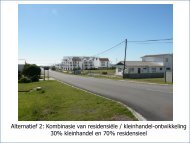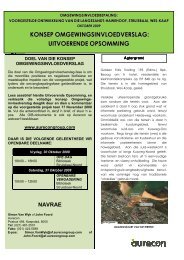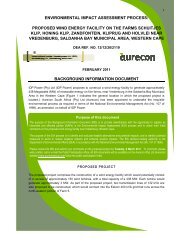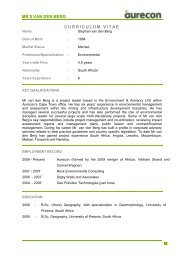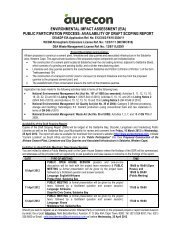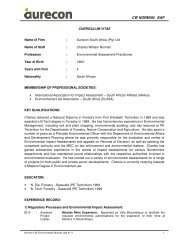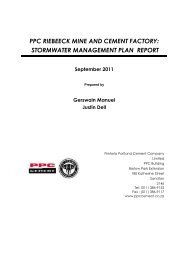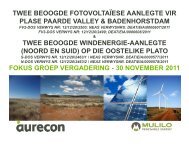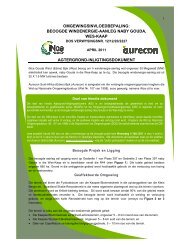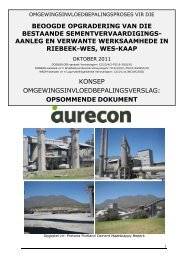Final EIAR - Aurecon AME Environmental | Environmental Projects
Final EIAR - Aurecon AME Environmental | Environmental Projects
Final EIAR - Aurecon AME Environmental | Environmental Projects
Create successful ePaper yourself
Turn your PDF publications into a flip-book with our unique Google optimized e-Paper software.
Proposed Wind and Solar (Photovoltaic) Energy Facilities on Kangnas Farm near Springbok in the Northern Cape: <strong>Final</strong> EIR 124<br />
The ‘crater’ might therefore represent a pan developed at a depression where surface water<br />
was unable to drain away as a result of the underlying structure. One other possible explanation<br />
is the depression was caused by a meteorite impact. The Kalkkom Crater bears a superficial<br />
resemblance to the Kalkkop Crater in the Easter Cape which was shown to be the result of a<br />
meteorite impact about 250 000 years ago (Reimold et al., 1998). Although the crater shape at<br />
Kalkkop is more obvious than at Kalkkom, this may be due to a difference in age or rate of<br />
erosion. The meteorite origin of Kalkkop was only proved as a result of drilling, which<br />
intersected shocked brecciated material below the base of the calcrete in the centre of the<br />
crater (at > 90 m depth).<br />
It was not possible to examine the bedrock that would have been the ‘target’ were this a<br />
meteorite impact crater due to the lack of bedrock exposures as a result of a 10 m of calcrete<br />
covering. According to Mr van Niekerk, the calcrete is typically about 10 m thick in the area, but<br />
is at least 80 m thick in the large crater.<br />
The only way to distinguish between these possible origins would be to undertake drilling<br />
(preferable core drilling) in the centre of the crater through the calcrete into the underlying<br />
bedrock.<br />
b) Impact assessment<br />
The construction phase of the wind and solar energy facilities would entail numerous,<br />
excavations into the superficial sediment cover and in some areas into the underlying bedrock<br />
as well. These include, for example, excavations for the proposed wind turbines and solar panel<br />
foundations, underground cables, new electricity transmission line pylons and substations, as<br />
well as new gravel access roads and any control / administrative buildings. In addition,<br />
substantial areas of bedrock would be sealed-in or sterilized by infrastructure such as lay-down<br />
and standing areas for the proposed wind turbines as well as new access roads. All these<br />
developments may adversely affect fossil heritage within the projects’ footprint by destroying,<br />
disturbing or permanently sealing-in fossils that are then no longer available for scientific<br />
research or other public good.<br />
Most surface rocks within study area are unfossiliferous but highly significant fossil material (e.g.<br />
dinosaur and mammal remains) occurs at small, localized sites (buried crater lake and alluvial<br />
deposits) within the site. Given the uncertainties concerning the patchy distribution of buried<br />
fossil heritage, predicted impacts for the proposed wind and solar energy facilities are not<br />
significantly different, and are considered unsure. However, these deposits are unlikely to be<br />
directly affected except by deeper excavations (> 3 m 33 ) that penetrate the generally<br />
unfossiliferous superficial deposits overlying them. The potential impacts on palaeontology from<br />
both the proposed wind energy facility and solar energy facility developments are considered to<br />
be of low intensity, local extent and long term and therefore of low (-) significance, with or<br />
without mitigation. No difference in significance would result from the proposed wind or solar<br />
alternatives.<br />
33<br />
It is possible that a number of the turbine foundations would be greater than 3 m deep. The<br />
palaeontologist has indicated that this would not change the significance rating.<br />
© <strong>Aurecon</strong> (2012) No unauthorised reproduction, copy<br />
or adaptation, in whole or in part, may be made.<br />
P:\<strong>Projects</strong>\108495 Kangnas WEF & PV EIA's\3 Project Delivery\4 Reports\FEIR\FEIR 210213 <strong>Final</strong>.doc


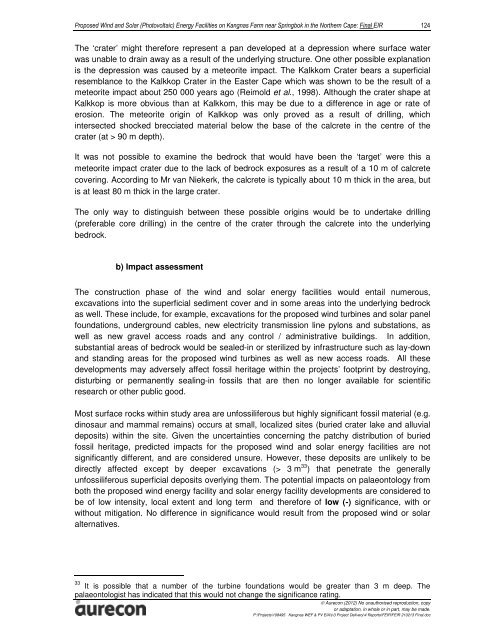
![CRR IV FEIR ~ 26042010 [FINAL].pdf - Environmental Projects](https://img.yumpu.com/21973020/1/184x260/crr-iv-feir-26042010-finalpdf-environmental-projects.jpg?quality=85)

